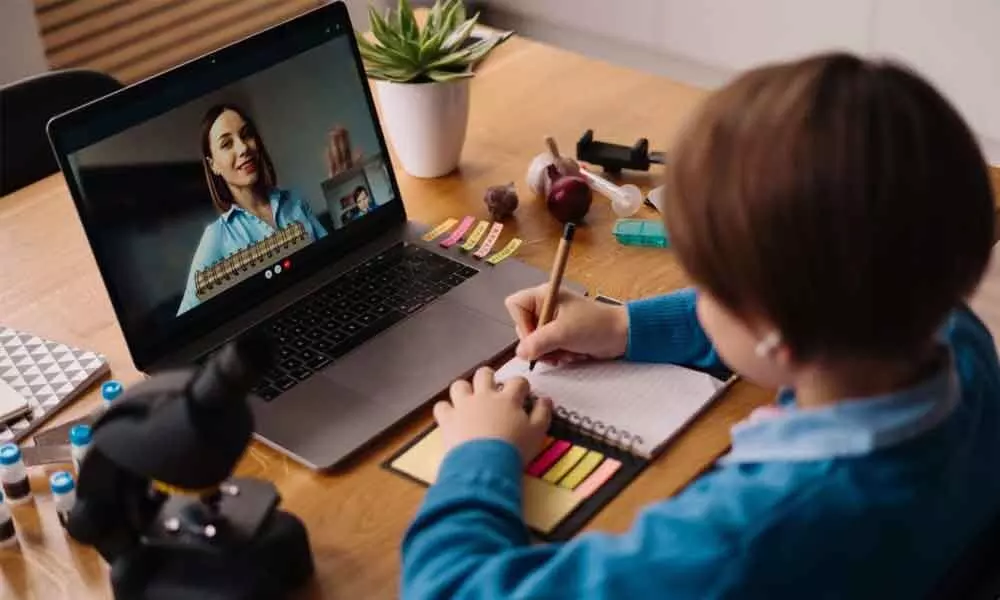Live
- Rachakonda police issues prohibitory orders in view of TGPSC tests
- SBI rescues sr citizen from `46L cyber fraud
- 12-yr-old dies of electrocution
- Installation of smart meters opposed
- State Cabinet expansion in focus as CM leaves for Delhi
- Need to reintroduce country’s forgotten pride: Bhagwat
- Pant shatters Iyer's IPL auction record, sold to Super Giants for Rs 27 cr
- Yuva Sangeetha Sammelanam held
- Dharani proves a bane for 25K families across State
- Reckless, Dangerous Arms Race
Just In
Techniques for remote learning and teaching


Representational Image
The Covid-19 pandemic has undeniably changed the popular attitude towards remote learning and has accelerated the adoption of e-learning platforms.
The Covid-19 pandemic has undeniably changed the popular attitude towards remote learning and has accelerated the adoption of e-learning platforms. While physical classes are beginning gradually, we may have to resort to online teaching and learning in the face of contingencies like the one we have witnessed in the past two years. And even in the normal times, the concept of blended learning is a valuable one, hence it is advisable for both students and teachers to keep in touch with and further refine their online teaching-learning practices.
Here are a few valuable tips for students to get the most out of an online learning scenario:
l Create and stick to a schedule- Scheduling not only makes you more productive, but it also structures your life, which is much required these days. A defined routine gives you a foundation on which to structure your day and develop a sense of normalcy and will not only help you be more productive, but it will also help you regain confidence and purpose, as well as contribute to your general psychological well-being.
l Consider an online course as though it were a traditional one- Remembering that you are taking an online class seriously, just as you would a regular class, is one of the easiest methods to ensure that you follow through. As if you were attending a typical in-person class If you want to get the most out of your lesson, you'll need to "show up."
l Make a commitment to yourself- Set objectives for yourself at the start of the semester and check in with yourself on a weekly basis. If you're having problems being accountable to yourself, team up with a classmate or friend as an accountability partner.
l Maintain a regular study place and keep organised- having a dedicated space to study helps you to stay focused. It's essential to figure out what kind of setting will benefit you the most. Make sure you have high-speed internet access wherever you go so you don't have to take an online course over a sluggish connection. Creating a regular workstation can also aid in your organisation. Knowing where essential dates, files, forms, syllabi, books, and assignments are stored can help you stay on track to meet your objectives.
l Ignore any distractions- Try shutting off your phone to prevent losing attention every time a text message or notification appears. If you're still having trouble resisting the impulse to check social media or explore the web, you might want to consider downloading a website blocker. Distractions may be reduced by using programmes like Cold Turkey and Freedom, which restrict apps or websites that compete for your attention.
Some tips for teachers
l Learn about your platform: The more familiar you are with the platform, the more at ease you will feel and the more professional you will appear to your students. Your self-assurance will instil trust in them. Be aware that not all students will access the site via a computer or laptop, and that things may seem very differently on other devices, not to mention the potential of downloading or uploading work. Check your settings to see what you want to allow pupils to do and what you don't want them to do.
l Have a two-way session: Make sure the class is participatory; this will allow you to gauge the children's level of interest.
l Utilize a variety of learning resources: The course should blend bursts of conversations, collaboration, video and audio snippets, and hands-on tasks with text and maybe brief video lectures to make the topic more intriguing and exciting, thus improving student engagement. If you're sending work, it's crucial to vary the kind of work you provide. Use internet resources; templates are helpful for worksheets, presentations, and other projects. Don't waste time attempting to make your own when you can choose from a variety of professionally made freebies to download and alter.
l Continue to provide feedback: Feedback is crucial in the classroom, and it must also be done online. An online student may feel alone at times because they lack the visual support system of a group. When teaching online, your feedback contributes to the experience of the student that the course is informative, interesting, and motivating. Continuous and constructive input is required. Provide comments as quickly as possible so that pupils may readily recognise what is correct and incorrect.
l Work along with other educators: Talk with other instructors on what works and what doesn't. Some systems allow for class co-hosting, which is especially useful with bigger groups when one teacher can provide instructions and the other can answer questions. It's possible that you'll be able to combine classes. You may share materials online, beneficial websites, technological know-how, and sometimes just feel like you're back on a teaching team.
(The author is the Founder of Deeksha)

© 2024 Hyderabad Media House Limited/The Hans India. All rights reserved. Powered by hocalwire.com






